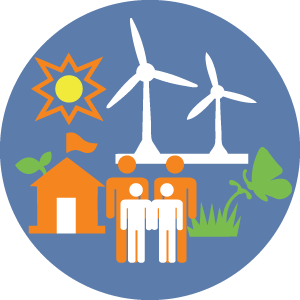OUR APPROACH
The Cloud Institute works with educators and their communities to prepare young people for the shift toward a sustainable future. We have developed an Education for Sustainability (EfS) Framework which guides our approach.
“You never change things by fighting the existing reality. To change something, build a new model that makes the existing model obsolete.” - Buckminster Fuller
“The significant problems we face cannot be solved with the same level of thinking we used to create them.” - Albert Einstein
The Cloud Institute’s EfS Framework
Our EfS Framework illustrates our whole systems approach, which springs from the recognition that lasting transformation in education requires innovation at the curricular, institutional, and community levels. No single element within our framework stands alone. Rather, all of the elements are interdependent and represent our learner-centered vision and our approach to educating for sustainability.
Our working definition of Education for Sustainability (EfS) is :
Education for Sustainability (EfS) is a set of transformative learning processes that equip students, teachers, and school systems with the new knowledge and ways of thinking we need to achieve economic prosperity and responsible citizenship while restoring the health of the living systems upon which our lives depend.
The Cloud Institute’s Education for Sustainability (EfS) Framework
The Learning Self
The Learning Self encompasses the knowledge, skills, attitudes and habits of mind that make it possible to live well within the means of nature.
Action Steps
Develop a shared understanding of sustainability and Education for Sustainability (EfS) within the school community and among key stakeholders.
Provide a shared professional development experience to develop a shared vocabulary and understanding that can be used to create change and sustain the on-going work of educating for sustainability.
Lead change in curriculum and instruction by developing and piloting exemplary EfS units, collecting, analyzing and presenting student work as evidence of EfS.
Create enthusiasm and make the feedback/results visible to the school community to inspire more action.
Provide on-going differentiated professional development and coaching in EfS core content, skills and instruction, EfS curriculum design and assessment using the EfS Content Standards and Performance Indicators.
Encourage and support student-led initiatives.
Communicate the goals, indicators, and results visibly and over time.
Celebrate!
The Learning Classroom
In the Learning Classroom, curriculum and instructional methodologies produce authentic and engaged learning.
Action Steps
Document and map the Operational Curriculum for the whole school/district.
Design/document units using backwards design and authentic assessment tools.
Map the vertical and lateral operating curriculum and assessments on a web based curriculum mapping or curriculum documentation tool.
Continually read the feedback (assess and analyze the curriculum, assessments and student work for evidence of EfS), and improve practices over time.
Conduct a strengths assessment and review gaps of the operating curriculum for evidence of EfS attributes.
Fully integrate the EfS Standards and Performance Indicators into the curriculum scope and sequence in the appropriate disciplines and grade levels.Integrate the physical plant changes directly into curricular innovations.
Celebrate!
Schools that Learn
In Schools that Learn, the organizational cultures and structures encourage innovation, collaboration, reflection and self-correction.
Action Steps
Collaboratively develop a strategic plan for EfS with goals, measurable indicators, benchmarks, and reasonable time lines.
Align performance assessments and incentives with the strategic plan.
Dedicate and align time, resources, funding, and deeper professional development (e.g. content, instruction, curriculum development and assessment) to the strategic plan.
Communicate the strategic plan to the whole school community and set expectations.
Identify organizational, curricular and physical changes required to accomplish the goals and develop an implementation plan.
Develop on-going participatory and collaborative leadership vision, and implementation practices.
Sustain vertical and lateral curriculum integration along with the organizational learning, assessment, reflection and revisions, and the physical plant improvements and maintenance.
Celebrate!
Physical Plant, Procurement and Investments
Buildings, grounds, procurement, operations and responsible investments positively contribute to the long-term health of our economic, ecological and social systems.
Action Steps
Conduct a baseline assessment of building materials, maintenance products, and of how the school community travels to and from school.
Set goals to source locally or regionally, reclaimed or recycled, sustainably harvested, non-toxic materials and products.
Set goals to increase the use of sustainable modes of transportation.
Track progress overtime and retrofit as appropriate.
Ensure the reduction, reuse, and recycling of materials is adopted as a fundamental function and responsibility of all members of the school environment.
Conduct an energy audit and take steps toward renewable sources and efficient uses of energy.
Consider the benefits of a green roof and, if possible, install with appropriate stakeholders (including students).
Develop a farm to school relationship, and make a plan to work with food services to include food that is regional, from school or community garden if possible, seasonal, and organic, has minimal or no-packaging, and contains no genetically modified organisms (GMOs).
Celebrate!
Communities that Learn
In Communities that Learn, stakeholders partner with schools to learn and work together toward a sustainable future.
Action Steps
Identify and develop authentic learning opportunities for students in the community.
Identify and develop relationships with key stakeholders as resources to the school/district.Identify community needs and develop ways the school can be an authentic resource to other schools and to the community.
Identify and develop ways in which the school(s) and community can learn together for a sustainable future.
Measure and track sustainable community indicators to produce and monitor evidence of success.
Celebrate!







